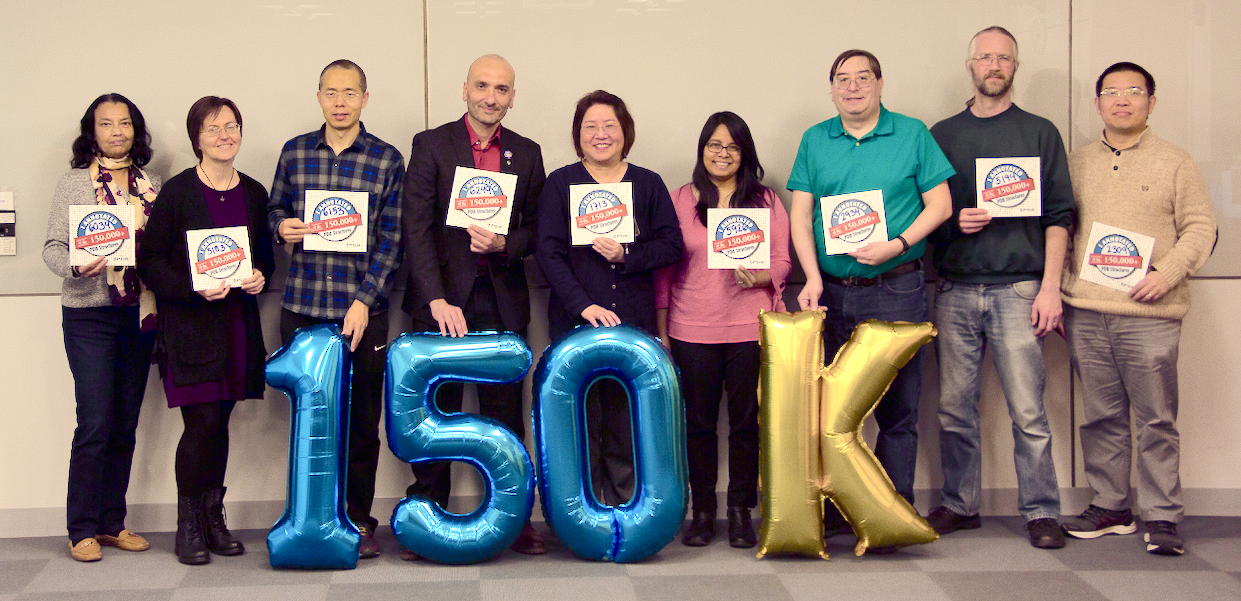Data Deposition/Biocuration Services and Archive Management
Deposition Statistics
In the second quarter of 2019, 3596 experimentally-determined structures were deposited to the archive. Data are processed by wwPDB partners RCSB PDB, PDBe, and PDBj.
87.5% were deposited with a release status of hold until publication; 8.4% were released as soon as annotation of the entry was complete; and 4.1% were held until a particular date.
83.3% of these entries were determined by X-ray crystallographic methods; 2.9% by NMR methods; and 13.5% by 3DEM.
During the same period, 2986 structures and 599 EMDB maps were released in the PDB.
OneDep Improvements: Ligand Validation Images and Electron Density Maps
OneDep is wwPDB's system for deposition, validation, and biocuration of PDB structure data. The latest release provides PDB depositors with two key tools: improved images of ligand validation and the electron density map coefficient files produced during validation.
In 2015, the wwPDB/CCDC/D3R Ligand Validation Workshop was held to discuss and develop best practices for validation of co-crystal structures. One recommendation from this meeting was to provide informative images of ligands in the presentation style of the Buster Report tool.
In collaboration with Global Phasing Limited, the Buster Report process has been integrated into the OneDep validation pipeline, with ligand geometry and fit to electron density now displayed in Validation Reports. CCDC Mogul analysis of bond lengths, bond angles, torsion angles and ring geometry are highlighted on a 2D diagram. Validation images will be generated for ligand/s of interest (LOI) as designated by the depositor and for any ligands with molecular weight greater than 250 Daltons that have outliers flagged in validation. This visual display of validation information gives a clear idea of where potential errors may have been made in modeling of the ligand in the PDB structure.
For crystal structures, the OneDep validation pipeline also displays the ligand and the surrounding electron density map to give a clear depiction of the quality of model fit to the data.
In addition to these validation images, OneDep now provides depositors with the electron density map coefficient files used in the validation process, reducing ambiguity between what is reported in validation and what the depositor observes from their own converted maps.

|

|
| wwPDB Validation Report for ligand NAP in PDB structure 1zk4. Validation is displayed per individual bond, with favorable validation in green, poor validation in magenta, and undefined validation in grey. |
Ligand electron density images, as displayed in the wwPDB validation report for ligand NAP in PDB structure 1zk4. The 2Fo-Fc density map is shown in grey, while the positive and negative Fo-Fc difference density maps are shown in green and magenta, respectively. |
For more information about the ligand validation images, see
O. Smart and G. Bricogne (2015) Achieving high quality ligand chemistry in protein-ligand crystal structures for drug design. In Multifaceted Roles of Crystallography in Modern Drug Discovery, P.D. Scapin G., Arnold E., ed. (Springer), pp. 165–181.
P. D. Adams, K. Aertgeerts, C. Bauer, J. A. Bell, H. M. Berman, T. N. Bhat, J. M. Blaney, E. Bolton, G. Bricogne, D. Brown, S. K. Burley, D. A. Case, K. L. Clark, T. Darden, P. Emsley, V. A. Feher, Z. Feng, C. R. Groom, S. F. Harris, J. Hendle, T. Holder, A. Joachimiak, G. J. Kleywegt, T. Krojer, J. Marcotrigiano, A. E. Mark, J. L. Markley, M. Miller, W. Minor, G. T. Montelione, G. Murshudov, A. Nakagawa, H. Nakamura, A. Nicholls, M. Nicklaus, R. T. Nolte, A. K. Padyana, C. E. Peishoff, S. Pieniazek, R. J. Read, C. Shao, S. Sheriff, O. Smart, S. Soisson, J. Spurlino, T. Stouch, R. Svobodova, W. Tempel, T. C. Terwilliger, D. Tronrud, S. Velankar, S. C. Ward, G. L. Warren, J. D. Westbrook, P. Williams, H. Yang, J. Young. (2016) Outcome of the First wwPDB/CCDC/D3R Ligand Validation Workshop. Structure 24: 502-508 doi: 10.1016/j.str.2016.02.017
Releasing Structures on Hold for Publication
Of all PDB structures deposited in 2018, ~88% were submitted with a release status of "hold until publication (HPUB)". Structures with HPUB status are released as part of the weekly update upon confirmation the corresponding article has been published (electronically or in print).
Structure authors should indicate publication using the OneDep Communication Panel. The wwPDB also receives publication dates and citation information directly from a few journals (see wwPDB's Information for Journals). For most articles, however, wwPDB searches PubMed and scans the literature for publication information. Citations emailed by users to deposit-help@mail.wwpdb.org are also greatly appreciated.
To be included in the following update, all required author correspondence should be sent to the appropriate wwPDB member by noon Thursday (local time).
Requests received after these cutoff times will be processed during the next update cycle.Mandatory PDBx/mmCIF format files submission for MX depositions
Submission of PDBx/mmCIF format files for crystallographic depositions to the PDB will be mandatory from July 1st 2019 onward. PDB format files will no longer be accepted for deposition of structures solved by MX techniques.
Announcing mandatory submission of PDBx/mmCIF format files for crystallographic depositions to the Protein Data Bank (PDB) (2019) Acta Crystallographica Section D 75: 451-454 doi: 10.1107/S2059798319004522
Join Our Team as a Biocurator
RCSB PDB is looking for a Biochemical Information & Annotation Specialist to join the RCSB PDB team at Rutgers, The State University of New Jersey.
Deposition/Biocuration Services support Data Depositors who submit the results of their structural studies of biological macromolecules to the PDB. All data deposited undergo expert review. Each structure is examined for self-consistency, standardized using controlled vocabularies, cross-referenced with other biological data resources, and validated for scientific/technical accuracy.
Biocurators communicate daily with members of the deposition community, and annotate, publicly release, and update entries in the PDB archive.
For more information, see
wwPDB biocuration supporting open access to high-quality 3D structural biology data (2018) Database 2018: bay002 doi: 10.1093/database/bay002
The rewards of working as a data wrangler Science Careers doi: 10.1126/science.caredit.aaq0481
For more, visit our Careers page or Contact Us with questions.

